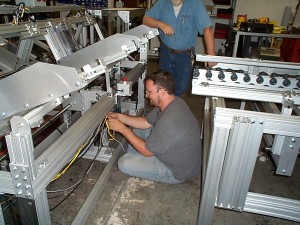The Lean/Six Sigma “Club”

As I work on my Six Sigma classes through Purdue I am reminded often of my previous experiences with companies who have Lean/Six Sigma programs. Back in the late nineties we did a lot of work for Avery Dennison, who manufactures a variety of office supplies; binders, pens, markers etc. Many of the processing and packaging machines we built were in response to Six Sigma initiatives trying to squeeze the last bit of waste out of each process. Margins are low and competition tough in this industry and there were a lot of Green and Black belt candidates working on these and other projects.
At the time I really didn’t know much about Lean and Six Sigma, but QS9000 and other programs were big at that time. I had unknowingly learned a lot of the terms and techniques associated with quality through my relationships with Japanese companies; Kaizen, Pokayoke, Kanban were all familiar terms. Many of the other buzzwords and acronyms such as CTQs, DPMO, JIT were Greek to me though and I remember thinking that the guys at Avery that were involved in the Six Sigma program seemed like they were part of an exclusive club whose techniques were secret and motives obscure.
Now as I go through my coursework I understand why that perception exists. Six Sigma buy-in is targeted toward the top of the organization. After all thats where the people who have the ability to enforce change are. It also turns out that the selection of Green and Black belt candidates is often based on who shows the most initiative and potential for advancement, i.e. the “Best and Brightest”. This invariably makes people feel special when they are chosen to participate in the program. The problem I saw with this is that it increases the stratification of the company. The engineering staff that worked on the plant floor in maintenance or production were rarely involved in the programs. Occasionally one would be selected for the Green belt program but this was often either seen as a ticket to an office and management job or an extra burden on an already overworked fire-fighter.
One of the questions posed in our classroom discussion was “What do you think is the key to success of Lean Six Sigma today?” In my opinion the key to success of this or many other programs is to involve everyone in the process and educate them in the techniques and terminology. It shouldn’t be seen as an extra burden or an exclusive club but as an opportunity for everyone to contribute to the improvement of the process. Part of my perception that the program was kind of a clique in the particular plant I was in, was the political climate of the workforce. There was truly a separation between management and labor, white collar and blue collar. This seems to be part of human nature and it is strongly reinforced by unionized plants. As an outside observer I didn’t have many preconceived notions about the program but I find it interesting viewing the content of the classes after this experience years ago. This selective buy-in and inward focus is actually one of the obstacles that the program warns of.
*May 1 2016: Check out these links

It is the best time to make some plans for the longer term and it is time to be happy. I’ve learn this submit and if I may just I want to recommend you few interesting things or advice. Maybe you can write subsequent articles regarding this article. I wish to read more issues about it!
Since I just finished my Six Sigma/Lean Manufacturing class through Purdue this weekend, my Sunday post will be on what I have gotten out of the classes. If you have any Lean experiences you would like to share on this site, please let me know. Thanks!